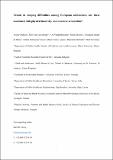Files in this item
Trends in sleeping difficulties among European adolescents : are these associated with physical inactivity and excessive screen time?
Item metadata
| dc.contributor.author | Ghekiere, Ariane | |
| dc.contributor.author | Van Cauwenberg, Jelle | |
| dc.contributor.author | Vandendriessche, Ann | |
| dc.contributor.author | Inchley, Jo | |
| dc.contributor.author | Gaspar de Matos, Margarida | |
| dc.contributor.author | Borraccino, Alberto | |
| dc.contributor.author | Gobina, Inese | |
| dc.contributor.author | Tynjälä, Jorma | |
| dc.contributor.author | Deforche, Benedicte | |
| dc.contributor.author | De Clercq, Bart | |
| dc.date.accessioned | 2019-12-10T00:36:48Z | |
| dc.date.available | 2019-12-10T00:36:48Z | |
| dc.date.issued | 2019-05 | |
| dc.identifier | 257047238 | |
| dc.identifier | d7de7165-b45a-45f5-b85a-8a189cd3c903 | |
| dc.identifier | 85058083309 | |
| dc.identifier | 000467914300004 | |
| dc.identifier.citation | Ghekiere , A , Van Cauwenberg , J , Vandendriessche , A , Inchley , J , Gaspar de Matos , M , Borraccino , A , Gobina , I , Tynjälä , J , Deforche , B & De Clercq , B 2019 , ' Trends in sleeping difficulties among European adolescents : are these associated with physical inactivity and excessive screen time? ' , International Journal of Public Health , vol. 64 , no. 4 , pp. 487–498 . https://doi.org/10.1007/s00038-018-1188-1 | en |
| dc.identifier.issn | 1661-8556 | |
| dc.identifier.other | ORCID: /0000-0001-8322-8817/work/65014255 | |
| dc.identifier.uri | https://hdl.handle.net/10023/19105 | |
| dc.description | The study was funded by the government of Flanders (Grant No. GEO-1GDD2A-WT) and the Research Foundation Flanders (Grant No. 12I1117N). | en |
| dc.description.abstract | Objectives We examined changes in sleep-onset difficulties over time and associations with physical activity and screen time behavior among adolescents. Methods We used data from last four survey waves of the Health Behavior in School-Aged Children (HBSC) study (2002–2006–2010–2014). Multilevel logistic regression analyses were conducted to explore associations between regular sleeping difficulties, excessive screen time exposure and being insufficiently physically active (i.e., < 60 min daily) among 33 European and non-European countries. Results Findings indicate an increase in the prevalence of sleep-onset difficulties and in excessive screen time exposure and a small but significant increase in physical activity levels. Additionally, adolescents exceeding 2-h daily screen time had 20% higher odds of reporting sleep-onset difficulties, while no association was found for physical activity. The strength of the association between screen time and sleep-onset difficulties increased over time, which may reflect a change in type of screen time use (e.g., the increased use of easy accessible screens such as smartphones and tablets). Conclusions Effective strategies to reduce screen time are key to reverse the detrimental trend in sleep-onset difficulties among adolescents. | |
| dc.format.extent | 12 | |
| dc.format.extent | 1998996 | |
| dc.language.iso | eng | |
| dc.relation.ispartof | International Journal of Public Health | en |
| dc.subject | 24-h approach | en |
| dc.subject | Sleep | en |
| dc.subject | Sedentary behavior | en |
| dc.subject | Physical activity | en |
| dc.subject | Trend | en |
| dc.subject | RJ101 Child Health. Child health services | en |
| dc.subject | Public Health, Environmental and Occupational Health | en |
| dc.subject | 3rd-NDAS | en |
| dc.subject | SDG 3 - Good Health and Well-being | en |
| dc.subject.lcc | RJ101 | en |
| dc.title | Trends in sleeping difficulties among European adolescents : are these associated with physical inactivity and excessive screen time? | en |
| dc.type | Journal article | en |
| dc.contributor.institution | University of St Andrews. Population and Behavioural Science Division | en |
| dc.contributor.institution | University of St Andrews. Child and Adolescent Health Research Unit | en |
| dc.contributor.institution | University of St Andrews. School of Medicine | en |
| dc.identifier.doi | 10.1007/s00038-018-1188-1 | |
| dc.description.status | Peer reviewed | en |
| dc.date.embargoedUntil | 2019-12-10 |
This item appears in the following Collection(s)
Items in the St Andrews Research Repository are protected by copyright, with all rights reserved, unless otherwise indicated.

